Product Requirements:
Something smooth and flat (like the
back of a cellular phone) upon which to it can be applied, 2 included and
user-replaceable CR1220 Li-Ion batteries
I used to have the mistaken idea that counterfeit money was created in near
deserted warehouses located on the fringes of large cities. In these imaginary
places, intricately carved steel plates on huge printing presses would churn out
near perfect impressions of fifty and one hundred dollar bills. Henchmen would
be stuffing the finished bills in dryers loaded with poker chips to give them
the appearance of wear, as they were overseen by a leather trench-coat wearing
character that looked suspiciously like Willem DaFoe in
To Live and Die in L.A.. Cue
the Wang Chung soundtrack…
However, I have recently completed a six month stint on the Tom Green County
Grand Jury. During this time, I have had my eyes opened to the fact that the
most commonly counterfeited bill in the United States is the twenty, and
they are easily made in home offices much like mine. That’s right, anyone
with a decent scanner, printer and some sheets of
rag paper can
generate a pretty good counterfeit twenty dollar bill. Chew on that for just a
moment.
Why counterfeit a twenty instead of something larger? Because a twenty dollar
bill is small enough that the average person will not become suspicious
when it is used to pay for goods. But it is also large enough that there
might be change… and any change received will be legitimate money.
Think about it – if you were to use a twenty to buy something as small as a $1
pack of gum, no one would think anything of it, much less remember you. Pull out
a hundred dollar bill in this day of debit and credit cards, and someone will
make it a point to remember the transaction, and that’s if the store will even
accept such a large bill.
Now obviously the counterfeited bill created in a home office won’t be
quite perfect, because it won’t have all of the new
security measures properly implemented in the paper. But how many people are
truly aware of what money is or isn’t supposed to look like? I mean, it
seems as if the US Mint keeps changing our larger denomination bills every
couple of years.
I think I am safe in saying that if the money someone gives us is the right
size, feels about how we expect it to, and looks like what we think we
remember is proper, then most of us have the reasonable expectation that the
bill we are holding will be real, and we will accept it as such.
Since it is common for counterfeit money to be passed in either places with
poor lighting (such as bars and restaurants), or places where there is a big
hurry to process people quickly (such as grocery stores), it is possible for it
to be accepted and not detected until it hits the bank. Once the "cash" is
examined at the bank and is determined to be counterfeit, it is confiscated and
the business or individual will be notified that their deposit is short that
amount.
There is no insurance that will pay for mistakenly accepted counterfeit
money, and there is no government agency that will trade it for real. Someone
that accepts a counterfeit bill from an unknown person is completely out of
luck. If they try to recoup their loss by passing the counterfeit bill on to
another, then they are in turn guilty of same.
If you think that your city doesn’t have a counterfeit problem, then you are
being naive. If my town of under 100,000 has counterfeit twenty dollar
bills floating around, then I guarantee that your city does too.
So how is the average person or business supposed to protect themselves from
accepting counterfeit bills? Interestingly enough, I have learned that
legitimate bills, credit cards and money orders will all have random or
deliberate areas of fluorescence which can be seen when they are exposed to
black light.
Through Google, I found a
site
that sells a tabletop Optical Counterfeit Detection unit, which is a fancy name
for a specialized black light. This looks like a great device to own if
you have a business where all money collected can be examined at one central
location. But what about individuals that need something more portable, or
businesses that have money collectors who are always on the move or standing in
places where it would be inconvenient to use such a large device? There has to
be a way that the average person can protect themselves from taking a loss from
counterfeit bills. Well, I have found one.
Today I’ll take a look at the Brando
Mobile Torch Bank Note
Detector, an item that I opened with much skepticism, but with which I am
now quite impressed…
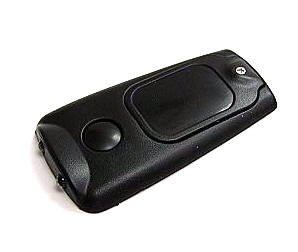
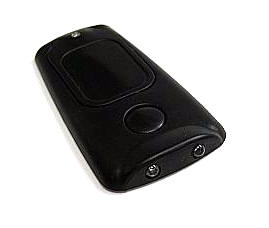
The torch measures approximately 2.25" long x 1.25" wide and 1/8" thick. It
is composed of black plastic with a removable battery compartment that is
secured with a tiny four-point screw. A round rubberized button activates the
two purple LED lights which shine from the wider end. The entire backside is
coated with a very sticky 3M adhesive to enable the detector to be affixed to
something that most of us almost always have handy – our mobile phone.
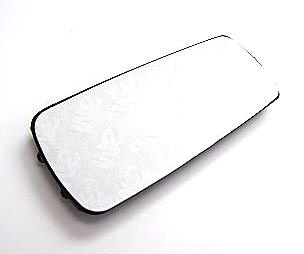
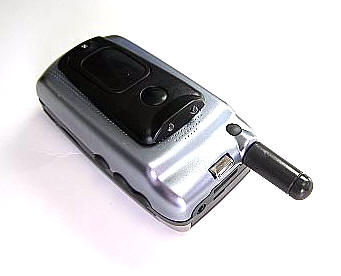
If you don’t want to stick anything to your phone, then it can also be
applied to any other smooth flat surface, or operated as a stand-alone unit.
The detector comes with CR1220 batteries already installed, but should they
burn out they would be user replaceable. According to the Brando site, a user
can expect about 20 hours of life from the batteries. The two purple lights are
LEDs, which should have the extraordinarily long life of approximately 100,000
hours if they are similar to other LED bulbs I have reviewed in the past.
Here’s how the detector works: In a darkened room, the user shines the the
LED lights on the bill, money order, or credit card. It will work in a room with
regular light, but the effect is much more dramatic the darker it is. If you are
looking at the genuine article, then there will be appropriate areas of
fluorescence. The following pictures will give you an idea of what you can
expect to see…
Money:
Here is what a twenty dollar bill looks like that has been scanned…it’s
pretty good, wouldn’t you say? If I were criminally inclined, I might just print
up a batch of them and who would be the wiser? Hopefully someone that knew what
to look for…
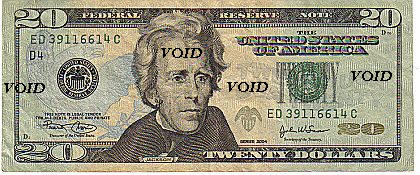
What you can’t see, and what would not show up in a printed bill, is the
fluorescent bar to the left of Andrew Jackson’s head. Here is what a twenty
looks like under black light, you’ll notice that the bar is very easy to see
when the bill is flipped over – in fact I could just about make out the words
"USA TWENTY" which appear both backwards and forwards.
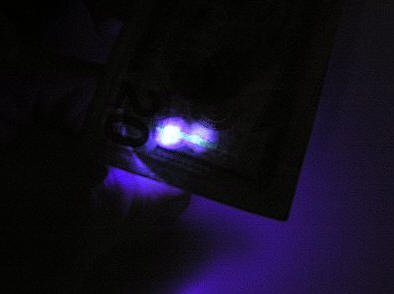
Simply stated, if the bill does not have the glowing thread, then one should
not feel safe accepting it. Though they are in different locations depending on
the denomination, this is true of all newer US bills.
As a matter of fact, just about every country’s currency will have some sort
of fluorescent markings, whether they just be random threads or elaborate
watermarks. Here are some more examples…
This twenty pound note has five vertical as well as five horizontal bars…
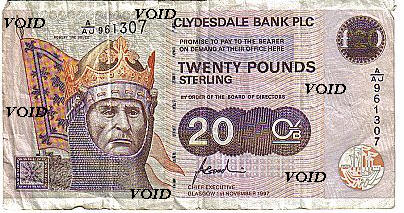
…which are only visible under black light. The fiver vertical bars are
spaced to the left of Robert The Bruce’s head, while the five horizontal bars
are in the vicinity of the "Twenty Pounds" label.
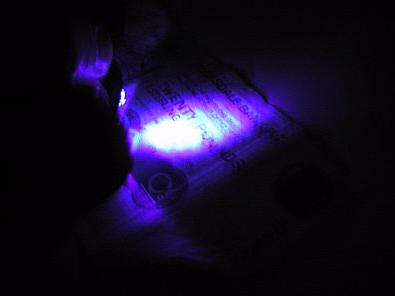
Here is an example of a bill that shows fluorescent fibers, the 250 Dinar
bill from Iraq (pre fall of Saddam Hussein)…
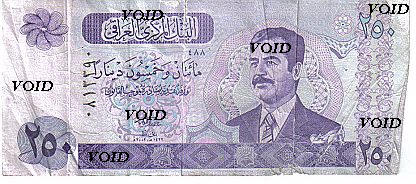
You can see one long fiber near the outer ring of the lights’ glow.
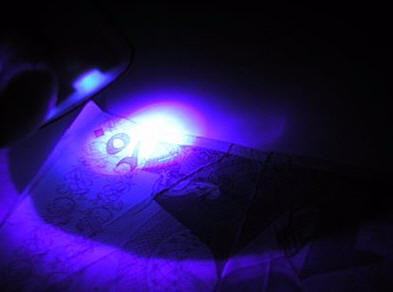
Money Orders: Perhaps you have heard that it is becoming more and more
common for USPS money orders to be counterfeited. Well, let’s take a look at one
and see how the detector can help with these…
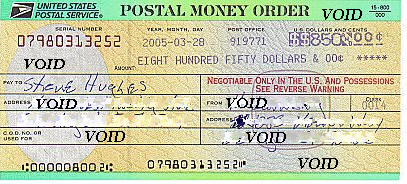
Here you can see that there is an elaborate Benjamin Franklin watermark that
shows very nicely, as well as a various fluorescent fibers. I was not able to
capture it, but there is also a security thread that runs in this general area.
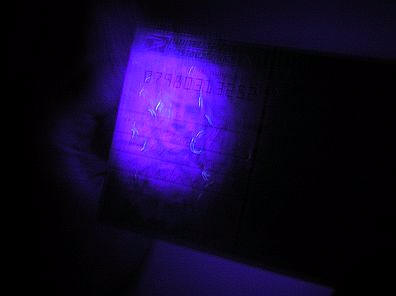
Credit Cards: While a black light won’t tell you if a credit card is
stolen or over its limit, it will tell you if it is a "real" card. Most
of us are aware that the letters "AMEX" are written across the front of an
American Express card in fluorescent ink…
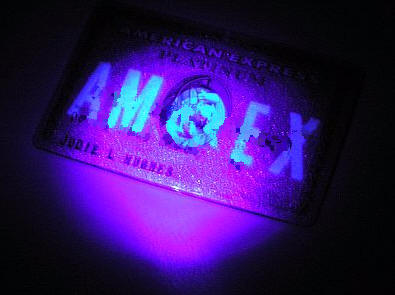
…but as I learned today, all credit cards have hidden symbols which
can only be viewed under a black light – like the picture of a dove on a Visa
card.
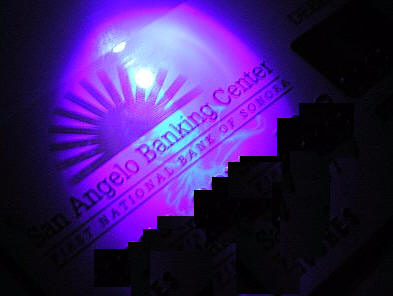
Armed with the Brando Mobile Torch Bank Note Detector, the average person can
feel pretty secure when taking bills and money orders in these times when
"desktop publishing" has taken on a whole new meaning. It’s not just people that
work in bars or restaurants that will benefit from a tool such as this, it is
ordinary people who are receiving change or making change for someone. In this
day of eBay and receiving money orders for goods sold, the Brando Mobile Torch
Bank Note Detector can be a valuable tool when assessing the legitimacy of
different forms of payment.
Price: $8
Pros:
Small and readily portable
Can be attached to mobile phone
Long battery life (20 Hours)
Inexpensive
Allows user to see built in fluorescent authenticity markings in currency,
credit cards and USPS money orders
Cons:
None
Google Review Tap Cards (3-Pack) by TapFive - Tap for Instant Reviews - All Phones Compatible - Reusable Smart Tap NFC & QR - Boost Business Reviews - Powered by TapFive (3 Card Pack)
$34.90 (as of 12/31/2025 03:47 GMT -06:00 - More infoProduct prices and availability are accurate as of the date/time indicated and are subject to change. Any price and availability information displayed on [relevant Amazon Site(s), as applicable] at the time of purchase will apply to the purchase of this product.)REVLIXI Google Review Stand -Boost Reviews w/Reusable Google Review Tap Card Stand & QR Code Stand- No App or Subscription - Android & iPhone Compatible-Boost Google Reviews for Online Growth
$24.89 (as of 12/30/2025 17:05 GMT -06:00 - More infoProduct prices and availability are accurate as of the date/time indicated and are subject to change. Any price and availability information displayed on [relevant Amazon Site(s), as applicable] at the time of purchase will apply to the purchase of this product.)Product Information
| Price: | 8.0 |
| Manufacturer: | Brando |
| Pros: |
|
| Cons: |
|


